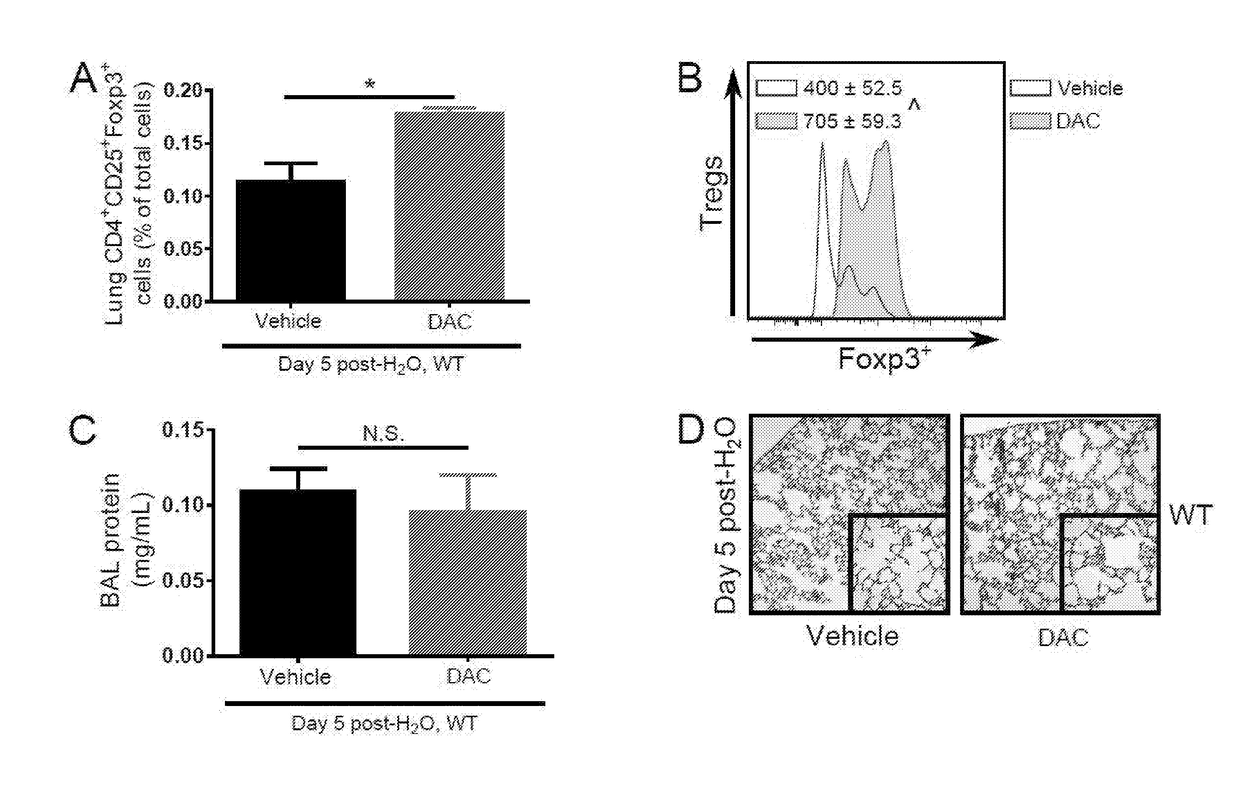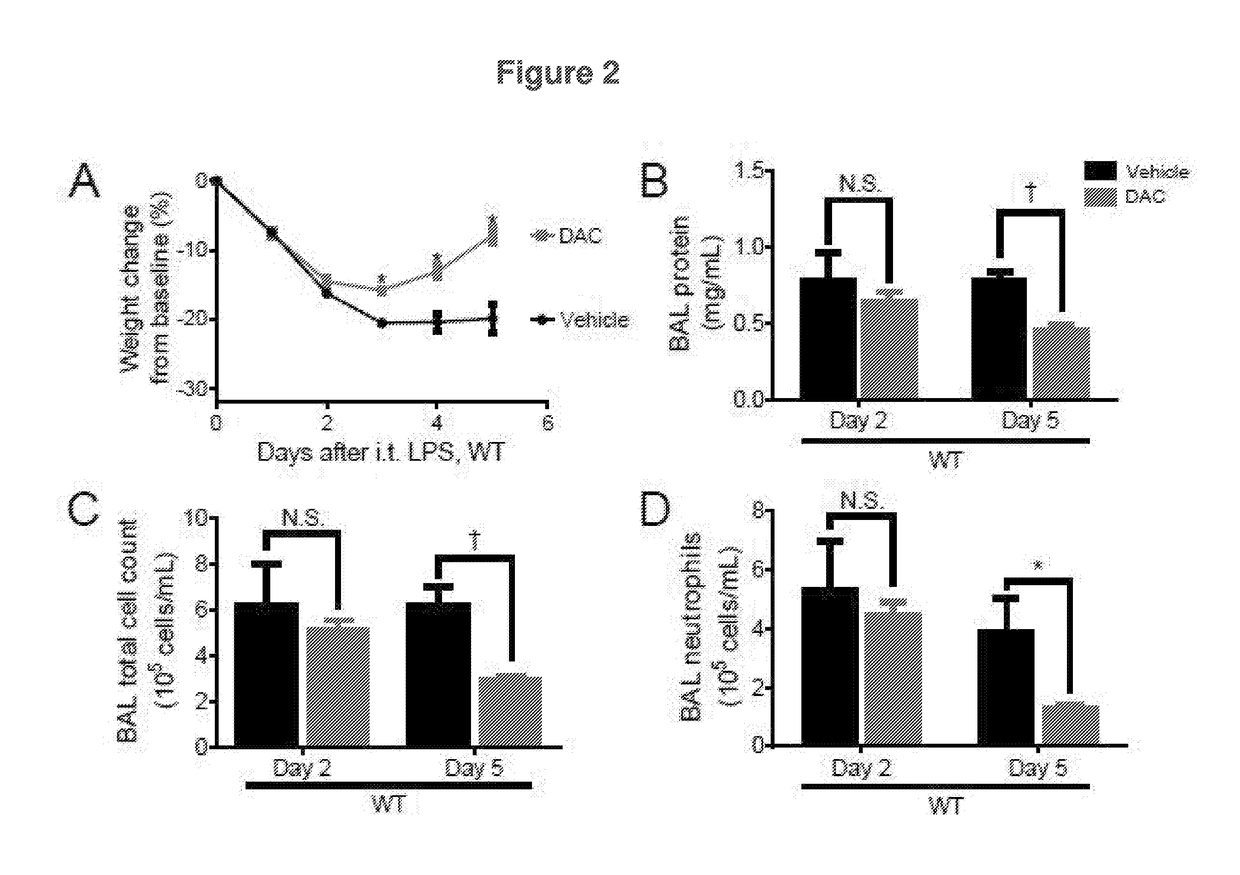Compositions and Methods to Accelerate Resolution of Acute Lung Inflammation
a technology of acute lung inflammation and compositions, applied in the direction of respiratory disorders, drug compositions, organic active ingredients, etc., can solve the problems of no effective therapies (e.g., cellular or pharmacotherapies) that promote the repair of the damaged lung, and the lymphocytes did not exist, so as to promote/enhance the recovery of the subject from lung injury
- Summary
- Abstract
- Description
- Claims
- Application Information
AI Technical Summary
Benefits of technology
Problems solved by technology
Method used
Image
Examples
example 1
Methods
[0306]Lung injury and Therapy: 5-aza-2′-deoxycytidine (DAC) was administered commencing 24 hours after intratracheal lipopolysaccharide-induced lung injury to wild type, lymphocyte-deficient recombinase activating gene-1-null (Rag-1− / −), and to Treg-depleted (diphtheria toxin-treated Foxp3DTR) mice. Lung injury phenotype during resolution was then measured. Furthermore, the specific effect of Treg DNA methyltransferase inhibition by adoptive transfer of ex vivo-treated Tregs to Treg-depleted mice following lung injury was assessed.[0307]Mice. C57BL / 6 wild type (WT) and Rag-1 mice were purchased from Jackson Laboratory (Bar Harbor, Me.). Foxp3DTR (B6.129(Cg)-Foxp3tm3Ayr / J) mice—which express a diphtheria toxin receptor-green fluorescent protein (DTR-GFP) fusion product from an internal ribosome entry site within the Foxp3 3′ untranslated region (1)—were a gift from Alexander Rudensky, PhD (Sloan-Kettering Institute, New York, N.Y.). Animals were bred and housed in a pathogen-f...
example 2
Overview: DAC Accelerated Recovery from LPS-Induced Acute Lung Injury
[0319]To test how dynamic DNA demethylation affects lung injury resolution, the DNA methyltransferase inhibitor 5-aza-2′-deoxycytidine (DAC) was administered to wild type mice beginning 24 hours after intratracheal lipopolysaccharide-induced lung injury. Mice that received DAC had similar early lung inflammation compared to vehicle-treated mice but exhibited accelerated resolution of their injury. Lung Tregs from DAC-treated wild type mice increased in frequency and displayed an enhanced activation state, suppressive phenotype, and proliferative capacity. Lymphocyte-deficient recombinase activating gene-1-null (Rag-1− / −) mice and Treg depleted (diphtheria toxin-treated Foxp3DTR) mice did not resolve their injury in response to DAC, confirming the criticality of both Rag-1 and Treg to the DAC therapy. Adoptive transfer of only 200,000 DAC-treated, but not vehicle-treated, exogenous Tregs rescued Treg-deficient mice ...
example 3
DAC Therapy Increased Lung Regulatory T Cell Frequency
[0320]The impact of DAC administration upon Treg frequency and Foxp3 expression was assessed in wild type (WT) mice under non-injurious circumstances, with the goal of ascertaining whether DAC treatment could expand lung Treg frequency and increase Foxp3 expression. As a sham condition for lung injury, WT mice received an intratracheal (i.t.) sterile water dose on day 0. They then received daily intraperitoneal (i.p.) DAC or vehicle on days 1 through 4. On day 5 post-water, increased lung Treg frequency was observed in DAC-treated mice, as compared to vehicle-treated mice (FIG. 1A and FIG. 13A). Lung Treg Foxp3 expression also increased in the DAC treatment group (FIG. 1B and FIG. 13B), as determined by FACS analysis using fluorochrome-conjugated antibodies. To ensure that neither the drug nor vehicle contributed to lung injury, bronchoalveolar lavage (BAL) was performed to assess total protein concentration (a lung permeability ...
PUM
| Property | Measurement | Unit |
|---|---|---|
| Frequency | aaaaa | aaaaa |
Abstract
Description
Claims
Application Information
 Login to View More
Login to View More - R&D
- Intellectual Property
- Life Sciences
- Materials
- Tech Scout
- Unparalleled Data Quality
- Higher Quality Content
- 60% Fewer Hallucinations
Browse by: Latest US Patents, China's latest patents, Technical Efficacy Thesaurus, Application Domain, Technology Topic, Popular Technical Reports.
© 2025 PatSnap. All rights reserved.Legal|Privacy policy|Modern Slavery Act Transparency Statement|Sitemap|About US| Contact US: help@patsnap.com



